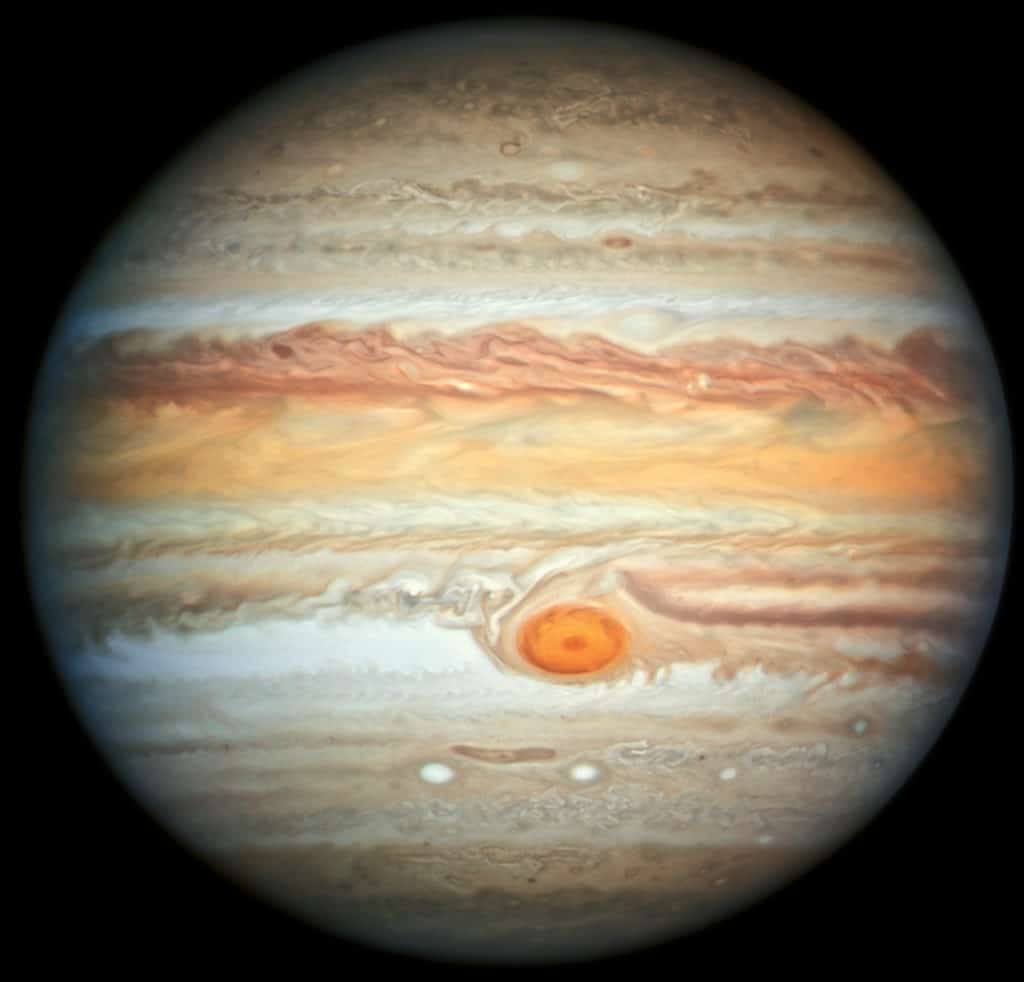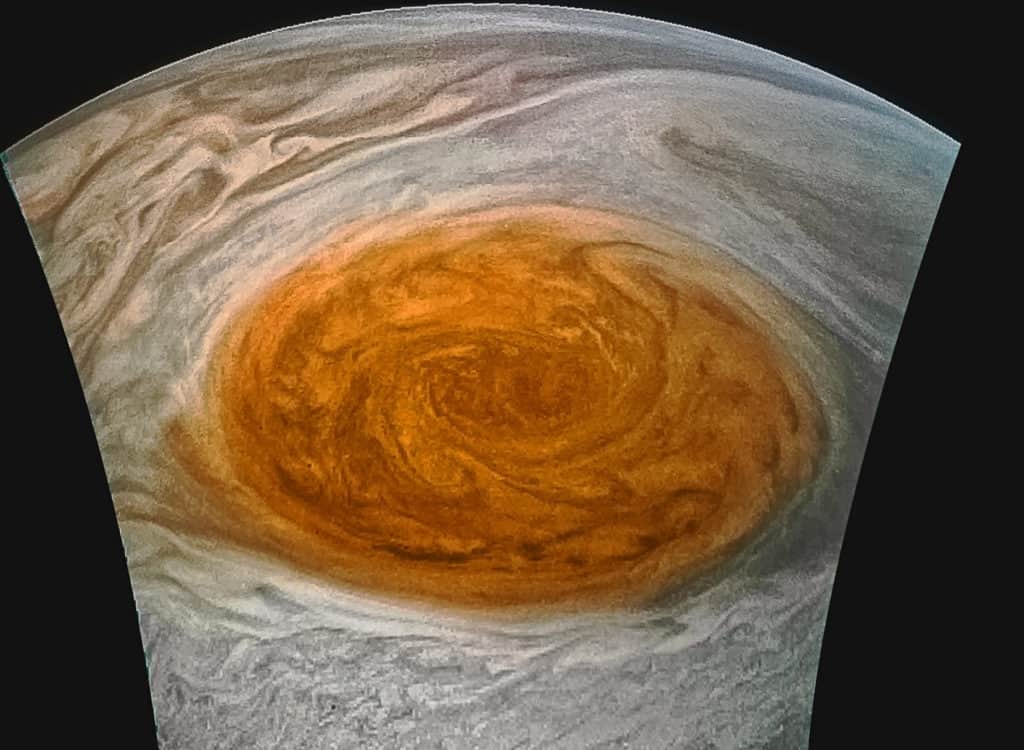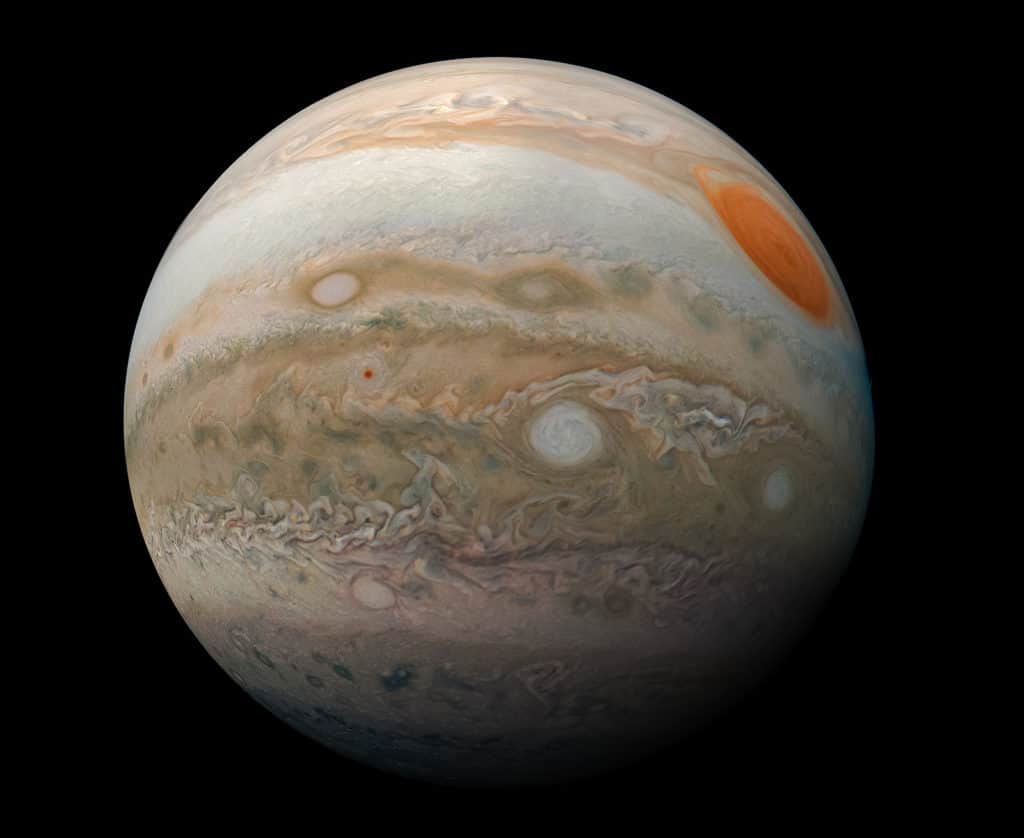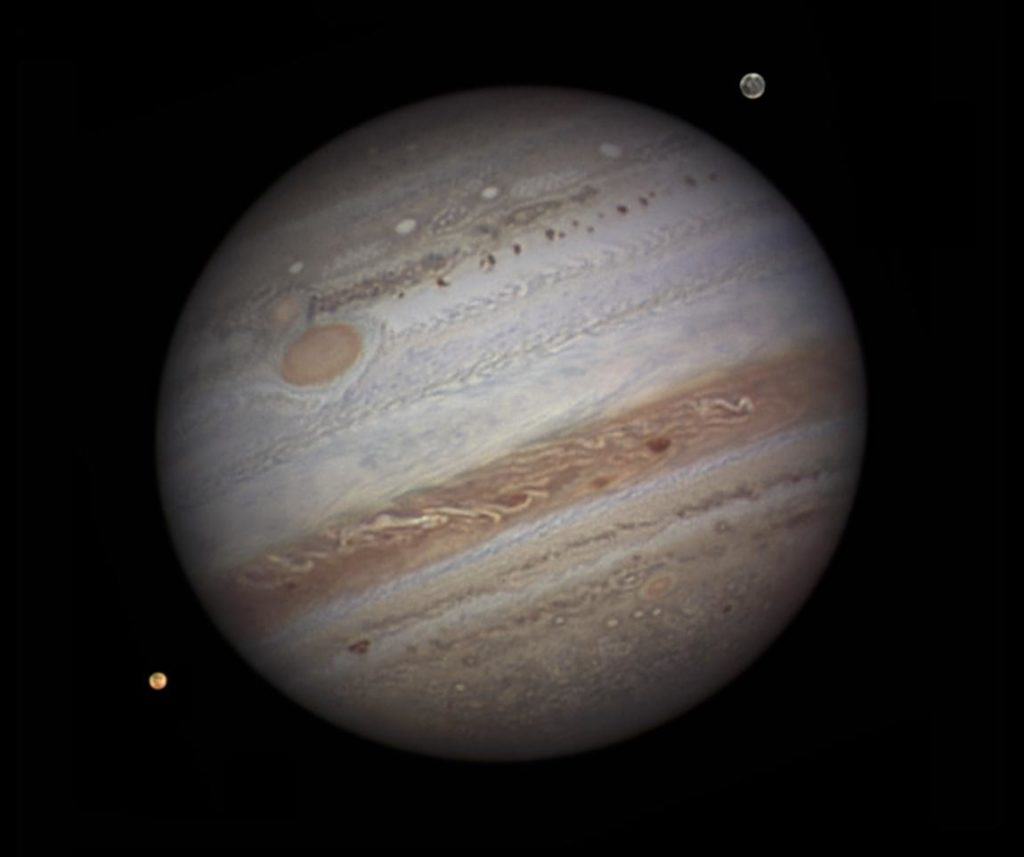The planet Jupiter is named after the supreme Roman god. To the ancient Greeks, he was known as Zeus, ruler of the Greek gods, and Mount Olympus.
Key Facts & Summary
- Jupiter is the fifth planet from the Sun and the biggest planet of our Solar System. Some consider it a failed star since it is made out of swirling gases and liquids such as 90% hydrogen, and 10% helium – very similar to the Sun.
- Jupiter is the fourth brightest object in the sky and one of the five visible planets ( Mercury, Venus, Mars, Saturn ).
- The envelope of gases – atmosphere – surrounding Jupiter is the largest planetary atmosphere in the Solar System. It makes up almost the entire planet. Basically, it doesn’t have a true surface with its atmosphere reaching altitudes of 5.000 km / 1.864 mi.
- Through the observations of Jupiter, the discovery of the four Galilean moons ended the belief that everything revolved around the Earth.
- Jupiter has a total of 79 confirmed moons. It is second only to Saturn when it comes to the total amount of satellites.
- Jupiter also has 3 ring systems but much smaller than Saturn’s.
- Though they can be seen only through ultraviolet, Jupiter’s auroras are the brightest in the Solar System.
- Jupiter has a mean radius of 69.911 kilometers / 43.440 miles, a diameter at the equator of around 142.984 km / 88.846 mi, and a diameter at the poles of 133.708 km / 83.082 mi.
- Jupiter’s mass is almost twice of all the Solar System’s planets combined. It is 318 times more massive than Earth.
- Jupiter is on average about 5.2 AU away from the Sun. One AU is equivalent to 150 million km / 93 million mi.
- Jupiter experiences 200 times more asteroid and comet impacts than Earth.
- In a way, Jupiter is the Solar System’s vacuum cleaner, because of its powerful gravity which attracts many of the comets and asteroids to hit it rather than other planets.
Jupiter is the fifth planet from the Sun and the largest planet of the Solar System. It is more than twice as massive as all the other planets combined, being 318 times bigger than Earth.
The planet is very similar to a star, but it never got big enough to start burning. Jupiter has rings surrounding it, but they are very faint and hard to see.

It is the planet with the second-most moons, 79, after Saturn, who has 82. The closest planets to Jupiter are Mars and Saturn. The planet can be seen with the naked eye, you don’t need a telescope or a pair of binoculars to see it.
Surface and Structure
Jupiter is a gas giant, just like Saturn. It is made mostly out of hydrogen and helium. It doesn’t have a true surface, but it may have a solid core about the size of Earth at its center.

Jupiter is covered in swirling cloud stripes and has enormous storms like the Great Red Spot, which has been going on for hundreds of years.
The atmosphere is very thick, and it is made out of ammonia, sulfur, methane, and water vapor. Jupiter’s atmosphere is the largest planetary atmosphere in the Solar System. It makes up almost the entire planet.
Time on Jupiter
A day on Jupiter goes by very fast. It only lasts for about 10 hours. However, since it is farther away from the Sun than Earth, one year on Jupiter – the time it takes for it to circle the Sun once – is equal to 11.8 Earth years.
Fun Facts
- If Jupiter would be 75 times more massive than it currently is, it would become a star just like our Sun.
- If you could somehow stand on Jupiter, and you would weigh 100 pounds on Earth, on Jupiter you would weigh 240 pounds due to the gravitational force. So basically, regardless of your weight, on Jupiter you would weigh 2.5 times more than on Earth.
- We don’t know how, but the ancient Babylonians wrote about Jupiter around 1.300 years ago. It may be the earliest recordings of the planet.
- Because Jupiter spins very fast, probably the fastest out of all the planets, it is flattened a bit so it bulges at its equator.
- The same speed gives power to Jupiter’s strong magnetic field which is around 20 times stronger than Earth’s. It is the most powerful magnetic field in the Solar System.
- Jupiter is surrounded by dangerous waves of radiation, and this makes it hard for spacecraft to approach it.
- The red spot on Jupiter was first seen in 1665 by an Italian astronomer named Giovanni Cassini.
- If you could go down on Jupiter, the thin, cold atmosphere would become thicker and hotter until it turns into a thick, dark fog. The pressure further down is so great that the gases become liquid.
Size and Comparison
Jupiter has a mean radius of 69.911 kilometers / 43.440 miles, a diameter at the equator of around 142.984 km / 88.846 mi, and a diameter at the poles of 133.708 km / 83.082 mi. It is the biggest planet in the Solar System.

Compared to Earth, it has more than 11 times its diameter. Around 1.300 Earth’s would fit inside Jupiter’s volume. In comparison to Mercury, the smallest planet in the Solar System, it is more than 29 times its diameter. More than 24.462 Mercury’s would fit inside Jupiter’s volume.
Venus is similar to Earth in size, it has less than 11.8 times the diameter of Jupiter. Mars, on the other hand, has less than 20 times the diameter of Jupiter. Jupiter has around 2.8 times the diameter of Neptune and Uranus. In comparison to Saturn, it has 1.2 times its diameter.
Trivia
More Mass, Less Size?
Though Jupiter is 2.5 times more massive than all the planets of the Solar System combine, scientists predict that if it would get more mass, the giant would actually get smaller.
More mass will make the planet more dense, and this would cause it to start pulling it in on itself.
Is Jupiter a failed star?
Though some consider Jupiter a failed star, it doesn’t have enough mass to trigger a fusion reaction in its core. That is the mechanism of how stars generate energy, by fusing hydrogen under extreme heat and pressure to create helium, releasing light and heat in the process.
This means that Jupiter has no way of becoming a star unless it would gain around 75 times more mass than it currently has.
Jupiter generates more heat than it receives from the Sun
Since it is the most massive planet in the Solar System, it is the closest to being a star, at least in terms of mass. Because of this mass, Jupiter generates high amounts of heat as it shrinks under gravity. It is unknown when Jupiter will stop shrinking.
Other Characteristics
The winds on Jupiter are very powerful. They are trapped in the planet’s wide bands of latitude. Each of these bands has a slightly different chemical make-up and temperature.

Because of this, some of the bands have different colors. The light-colored bands are called “zones.” The dark-colored bands are called “belts”.
These clouds are different in color, depending on the altitude. Blue clouds are the lowest, followed by brown and white clouds. Red clouds are the highest.
The Great Red Spot is big enough to hold two Earths. It is a high-pressure region where clouds are much higher and colder than in the surrounding areas. Jupiter also has other spots, but they are far smaller.
Jupiter is very bright in the night sky, second only to Venus. The four most important moons of Jupiter, called the Galilean moons, are also quite visible, but you would need a pair of binoculars to see them.

One of the most important moons of Jupiter is Europa. This moon may have water on it, and it is currently closely studied. Another interesting moon of Jupiter is Io, which is the most volcanically active body in the Solar System.
Scientists believe that Jupiter was twice its current size when it was formed. The giant planet is constantly bombarded with asteroids and comets, almost 200 times more than Earth.
Jupiter Notes
- Jupiter is the largest planet of the Solar System. It is the fifth planet from the Sun.
- Jupiter is a gas giant, and it lacks a true surface. It is made up of about 90% hydrogen and 10% helium.
- Jupiter has a faint ring system, and it is second in terms of the number of satellites only to Saturn. It has 79 moons, four of them, the Galilean moons, helped shape our view of the Universe.
- Jupiter’s moon Europa has many chances of developing life.
- Jupiter shrinks 2 centimeters every year because it radiates too much heat.
Sources:
[1.] NASA
[2.] Wikipedia
Image sources:
- https://solarsystem.nasa.gov/system/feature_items/images/11_stsci-h-p1936a_800.jpg
- https://www.nasa.gov/sites/default/files/thumbnails/image/pia21772.jpg
- https://cdn.mos.cms.futurecdn.net/rCdTVsPesASiv3JeVyhHsa-1200-80.jpg
- https://www.nasa.gov/sites/default/files/thumbnails/image/pia22946-16.jpg
- https://www.nasa.gov/sites/default/files/images/627807main_PIA14410_full.jpg
